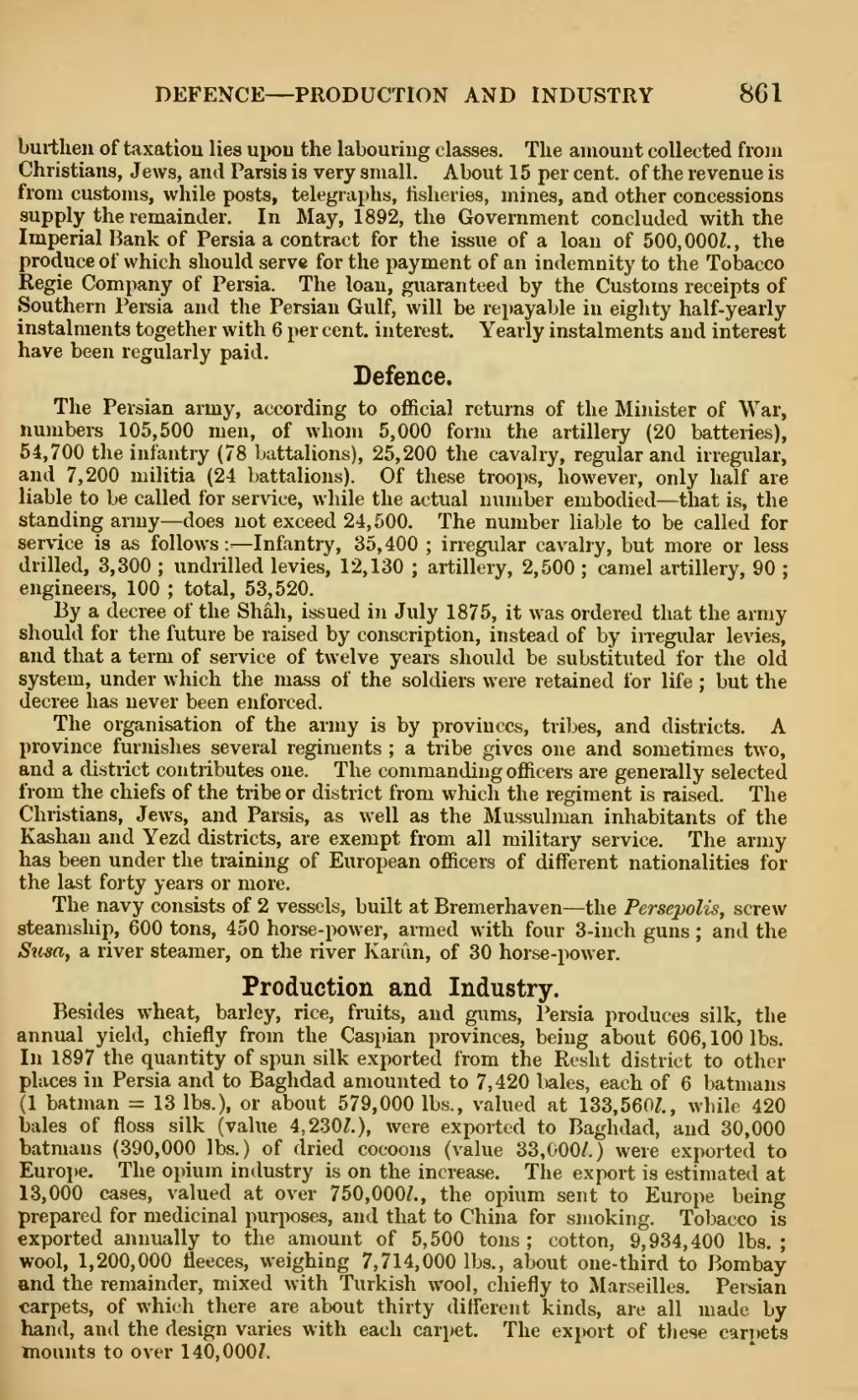DEFENCE — PRODUCTION AND INDUSTRY 861
buithen of taxation lies upon the labouring classes. The amount collected from Christians, Jews, and Parsis is very small. About 15 per cent, of the revenue is from customs, while posts, telegraphs, fisheries, mines, and other concessions supply the remainder. In May, 1892, the Government concluded with the Imperial Bank of Persia a contract for the issue of a loan of 500,000Z. , the produce of which should serve for the payment of an indemnity to the Tobacco Regie Company of Persia. The loan, guaranteed by the Customs receipts of Southern Persia and the Persian Gulf, will be repayable in eighty half-yearly instalments together with 6 per cent, interest. Yearly instalments and interest have been regularly paid.
Defence.
The Persian army, according to official returns of the Minister of War, numbers 105,500 men, of whom 5,000 form the artillery (20 batteries), 54,700 the infantry (78 battalions), 25,200 the cavalry, regular and irregular, and 7,200 militia (24 battalions). Of these troops, however, only half are liable to be called for service, while the actual number embodied — that is, the Standing army — does not exceed 24,500. The number liable to be called for service is as follows := — Infantry, 35,400 ; irregular cavalry, but more or less drilled, 3,300 ; undrilled levies, 12,130 ; artillery, 2,500 ; camel artillery, 90 ; engineers, 100 ; total, 53,520.
By a decree of the Shah, issued in July 1875, it was ordered that the army should for the future be raised by conscription, instead of by irregular levies, and that a term of service of twelve years should be substituted for the old system, under which the mass of the soldiers were retained for life ; but the decree has never been enforced.
The organisation of the army is by provinces, tribes, and districts. A province furnishes several regiments ; a tribe gives one and sometimes two, and a district contributes one. The commanding officers are generally selected from the chiefs of the tribe or district from which the regiment is raised. The Christians, Jews, and Parsis, as well as the Mussulman inhabitants of the Kashau and Yezd districts, are exempt from all military service. The army has been under the training of European officers of different nationalities for the last forty years or more.
The navy consists of 2 vessels, built at Bremerhaven — the Persepolis, screw steamship, 600 tons, 450 horse-power, armed with four 3-inch guns ; and the Susa, a river steamer, on the river Karun, of 30 horse-power.
Production and Industry.
Besides wheat, barley, rice, fruits, and gums, Persia produces silk, the annual yield, chiefly from the Caspian provinces, being about 606,100 lbs. In 1897 the quantity of spun silk exported from the Reslit district to other places in Persia and to Baghdad amounted to 7,420 bales, each of 6 batmans (1 batman = 13 lbs.), or about 579,000 lbs., valued at 133,560Z., while 420 bales of floss silk (value 4,230Z.), were exported to Baghdad, and 30,000 batmans (390,000 lbs.) of dried cocoons (value 33,000/.) were exported to Euroi)e. The opium industry is on the increase. The export is estimated at 13,000 cases, valued at over 750,000/., the opium sent to Europe being prepared for medicinal purposes, and that to China for smoking. Tobacco is exported annually to the amount of 5,500 tons; cotton, 9,934,400 lbs.; wool, 1,200,000 fleeces, weighing 7,714,000 lbs., about one-third to Bombay and the remainder, mixed with Turkish wool, chiefly to Marseilles. Persian carpets, of which there are about thirty different kinds, are all made by hand, and the design varies with each carpet. The export of these carpets mounts to over 140, 000 Z.

